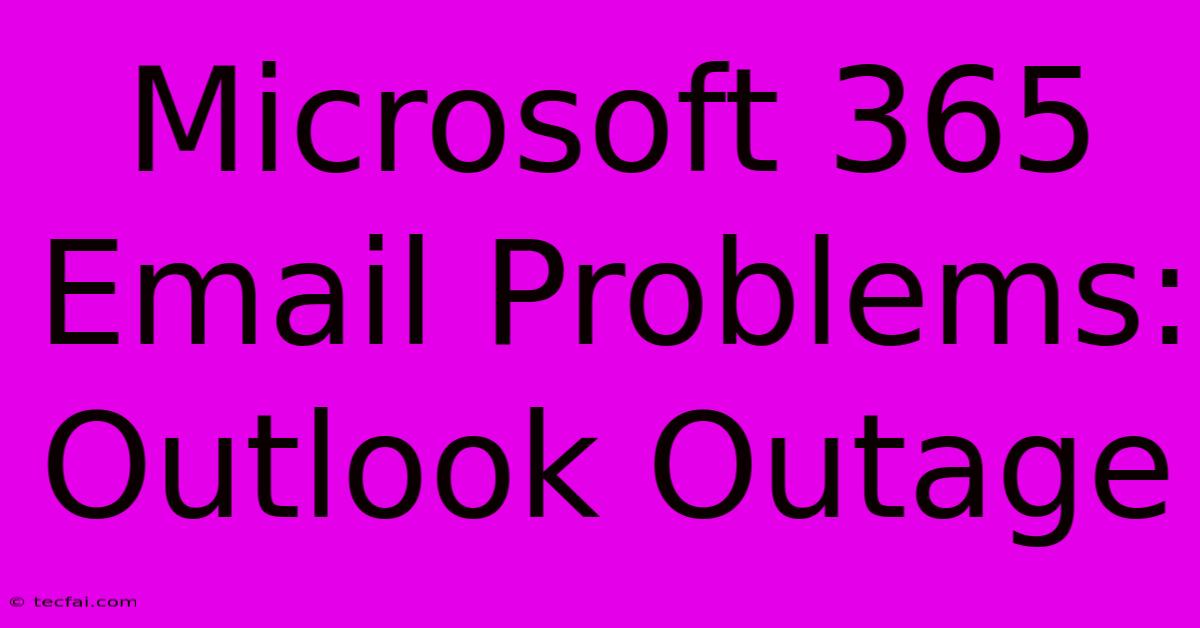Microsoft 365 Email Problems: Outlook Outage

Discover more detailed and exciting information on our website. Click the link below to start your adventure: Visit Best Website tecfai.com. Don't miss out!
Table of Contents
Microsoft 365 Email Problems: Outlook Outage
Experiencing issues with your Microsoft 365 email? A widespread Outlook outage can be incredibly disruptive, impacting productivity and communication. This guide will help you understand the common causes of Outlook outages, troubleshoot potential problems on your end, and provide steps to stay informed during widespread service disruptions.
Understanding Microsoft 365 Email Outages
Microsoft 365, while generally reliable, is susceptible to outages. These can range from brief, localized glitches affecting only a few users, to major service disruptions impacting millions. Several factors contribute to these problems:
-
Server-Side Issues: The most common cause is a problem within Microsoft's infrastructure. This could be anything from planned maintenance (rarely causing significant disruptions) to unforeseen technical difficulties impacting servers, network connectivity, or software updates.
-
DNS Problems: Domain Name System (DNS) issues can prevent your computer from correctly locating the Microsoft 365 email servers. This can lead to connection errors.
-
Network Connectivity: Problems with your internet connection, firewall settings, or router configuration can hinder access to your email.
-
Application-Specific Glitches: Bugs within the Outlook application itself can occasionally lead to connection issues, even if the Microsoft 365 servers are functioning correctly.
Troubleshooting Microsoft 365 Email Problems
Before assuming a widespread outage, check these troubleshooting steps:
1. Check Microsoft 365 Service Status
The first and most crucial step is to verify if the problem is on Microsoft's side. Microsoft provides official service status pages that show the current health of its services, including Outlook. Checking this page should be your very first action.
2. Restart Your Computer and Router
A simple reboot can often resolve temporary network glitches. Restarting both your computer and your internet router can clear any minor connection issues.
3. Check Your Internet Connection
Ensure you have a stable internet connection. Try accessing other online services to rule out a broader internet problem.
4. Verify Outlook Application Settings
Ensure your Outlook application is configured correctly with the correct Microsoft 365 credentials.
5. Check Your Firewall and Antivirus Software
Overly restrictive firewall or antivirus settings might be blocking access to the Microsoft 365 servers. Temporarily disable them (if you're comfortable doing so and understand the security implications) to see if this resolves the issue. Remember to re-enable them afterward.
6. Update Outlook
Make sure you're running the latest version of the Outlook application. Outdated software can sometimes contain bugs that cause connection problems.
Staying Informed During an Outlook Outage
During a widespread outage, staying informed is key:
-
Follow Microsoft's Official Channels: Microsoft usually announces outages and provides updates via its official service status pages, social media accounts, and news channels. Rely on these sources for accurate information.
-
Check Third-Party Status Pages: Several third-party websites track Microsoft 365 service status. While useful, always prioritize information from official Microsoft sources.
-
Contact Microsoft Support (If Necessary): If troubleshooting steps fail and the outage persists, contact Microsoft support for assistance.
Preventing Future Email Problems
While you can't prevent every outage, taking proactive steps can minimize disruptions:
-
Regularly Update Outlook: Ensure your Outlook application is always up-to-date.
-
Implement Backup Solutions: Consider using a third-party email backup service to protect your email data in case of unforeseen issues.
-
Use Multiple Communication Methods: Don't rely solely on email. Diversify your communication channels to maintain connectivity even during outages.
By understanding the common causes of Outlook outages and following these troubleshooting steps, you can minimize downtime and maintain productivity. Remember, patience is key during widespread service disruptions. Microsoft is usually quick to resolve issues, and staying informed through their official channels will help you navigate these situations effectively.

Thank you for visiting our website wich cover about Microsoft 365 Email Problems: Outlook Outage. We hope the information provided has been useful to you. Feel free to contact us if you have any questions or need further assistance. See you next time and dont miss to bookmark.
Featured Posts
-
Fide World Chess 2024 Top Trends
Nov 26, 2024
-
Black Friday Steam Deck 33 Discount
Nov 26, 2024
-
Chess Grandmaster Hotel Stay Hungary
Nov 26, 2024
-
Watch Celtics Vs Clippers Live
Nov 26, 2024
-
Timberwolves Vs Celtics Panuorin Ngayon
Nov 26, 2024
